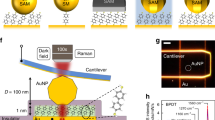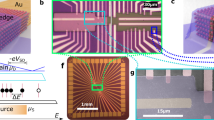Abstract
The self-assembly of organic molecules on surfaces is a promising approach for the development of nanoelectronic devices1,2. Although a variety of strategies have been used to establish stable links between molecules2,3,4,5,6,7,8,9,10,11, little is known about the electrical conductance of these links. Extended electronic states, a prerequisite for good conductance, have been observed for molecules adsorbed on metal surfaces12,13,14,15,16. However, direct conductance measurements through a single layer of molecules are only possible if the molecules are adsorbed on a poorly conducting substrate. Here we use a nanoscale four-point probe17 to measure the conductivity of a self-assembled layer of cobalt phthalocyanine on a silver-terminated silicon surface as a function of thickness. For low thicknesses, the cobalt phthalocyanine molecules lie flat on the substrate, and their main effect is to reduce the conductivity of the substrate. At higher thicknesses, the cobalt phthalocyanine molecules stand up to form stacks and begin to conduct. These results connect the electronic structure and orientation of molecular monolayer and few-layer systems to their transport properties, and should aid in the rational design of future devices.
This is a preview of subscription content, access via your institution
Access options
Subscribe to this journal
Receive 12 print issues and online access
$259.00 per year
only $21.58 per issue
Buy this article
- Purchase on Springer Link
- Instant access to full article PDF
Prices may be subject to local taxes which are calculated during checkout


Similar content being viewed by others
References
Joachim, C., Gimzewski, J. K. & Aviram, A. Electronics using hybrid-molecular and mono-molecular devices. Nature 408, 541–548 (2000).
Barth, J. V., Costantini, G. & Kern, K. Engineering atomic and molecular nanostructures at surfaces. Nature 437, 671–679 (2005).
Yokoyama, T., Yokoyama, S., Kamikado, T., Okuno, Y. & Mashiko, S. Selective assembly on a surface of supramolecular aggregates with controlled size and shape. Nature 413, 619–621 (2001).
Lin, N., Dmitriev, A., Weckesser, J., Barth, J. V. & Kern, K. Real-time single-molecule imaging of the formation and dynamics of coordination compounds. Angew Chem. Int. Ed. 41, 4779–4783 (2002).
Theobald, J. A., Oxtoby, N. S., Phillips, M. A., Champness, N. R. & Beton, P. H. Controlling molecular deposition and layer structure with supramolecular surface assemblies. Nature 424, 1029–1031 (2003).
Barth, J. V., Weckesser, J., Lin, N., Dmitriev, A. & Kern, K. Supramolecular architectures and nanostructures at metal surfaces. Appl. Phys. A 76, 645–652 (2003).
van Hameren, R. et al. Macroscopic hierarchical surface patterning of porphyrin trimers via self-assembly and dewetting. Science 314, 1433–1436 (2006).
Grill, L. et al. Nano-architectures by covalent assembly of molecular building blocks. Nature Nanotech. 2, 687–691 (2007).
Weigelt, S. et al. Covalent interlinking of aldehydes and amines on Au(111) under ultrahigh vacuum conditions. Angew Chem. Int. Ed. 46, 9227–9230 (2007).
Yin, P., Choi, H. M. T., Calvert, C. R. & Pierce, N. A. Programming biomolecular self-assembly pathways. Nature 451, 318–323 (2008).
Veld, M. I., Iavicoli, P., Haq, S., Amabilino, D. B. & Raval, R. Unique intermolecular reaction of simple porphyrins at a metal surface gives covalent nanostructures. Chem. Commun., 1536–1538 (2008).
Netzer, F. P. Determination of structure and orientation of organic molecules on metal surfaces. Vacuum 41, 49–53 (1990).
Graen, H. H., Neuber, M., Neumann, M., Odorfer, R. G. & Freund, H. J. Lateral interaction in ordered hydrocarbon overlayers — C–H band dispersion of adsorbed benzene. Europhys. Lett. 12, 173–177 (1990).
Yang, W. et al. Band structure and Fermi surface of electron-doped C60 monolayers. Science 300, 303–307 (2003).
Temirov, R., Soubatch, S., Luican, A. & Tautz, F. S. Free-electron-like dispersion in an organic monolayer film on a metal substrate. Nature 444, 350–353 (2006).
Yamane, H. et al. Electronic structure at highly ordered organic/metal interfaces: Pentacene on Cu(110). Phys. Rev. B 76, 165436 (2007).
Gammelgaard, L. et al. A complementary metal-oxide-semiconductor compatible monocantilever 12-point probe for conductivity measurements on the nanoscale. Appl. Phys. Lett. 93, 093104 (2008).
Upward, M. D., Beton, P. H. & Moriarty, P. Adsorption of cobalt phthalocyanine on Ag terminated Si(111). Surf. Sci. 441, 21–25 (1999).
Gustafsson, J. B., Zhang, H. M., Moons, E. & Johansson, L. S. O. Electron spectroscopy studies of PTCDA on Ag/Si(111)–√3 × √3. Phys. Rev. B 75, 155413 (2007).
Gustafsson, J. B., Zhang, H. M. & Johansson, L. S. O. STM studies of thin PTCDA films on Ag/Si(111)–√3 × √3. Phys. Rev. B 75, 155414 (2007).
Hofmann, Ph. & Wells, J. W. Surface-sensitive conductance measurements. J. Phys. Condens. Matter 21, 013003 (2009).
Crain, J. N., Gallagher, M. C., McChesney, J. L., Bissen, M. & Himpsel, F. J. Doping of a surface band on Si(111)√3 × √3–Ag. Phys. Rev. B 72, 045312 (2005).
Nakajima, Y., Uchida, G., Nagao, T. & Hasegawa, S. Two-dimensional adatom gas on the Si(111)–(√3 × √3)–Ag surface detected through changes in electrical conduction. Phys. Rev. B 54, 14134–14138 (1996).
Gould, R. D. Structure and electrical conduction properties of phthalocyanine thin films. Coord. Chem. Rev. 156, 237–274 (1996).
Craciun, M. F. et al. Electronic transport through electron-doped metal phthalocyanine materials. Adv. Mater. 18, 320–324 (2006).
Wells, J. W., Kallehauge, J. F. & Hofmann, Ph. Surface-sensitive conductance measurements on clean and stepped semiconductor surfaces: Numerical simulations of four point probe measurements. Surf. Sci. 602, 1742–1749 (2008).
Wells, J. W., Kallehauge, J. F. & Hofmann, Ph. Thermal switching of the electrical conductivity of Si(111)(√3 × √3)Ag due to a surface phase transition. J. Phys. Condens. Matter 19, 176008 (2007).
Nitzan, A. & Ratner, M. A. Electron transport in molecular wire junctions. Science 300, 1384–1389 (2003).
Wu, S. et al. Molecular junctions based on aromatic coupling. Nature Nanotech. 3, 569–574 (2008).
Acknowledgements
We acknowledge useful discussions with P. Petersen, M. Balslev, J. Hansen, T. Hansen and P. Bøggild. Ph.H. thanks the Leverhulme Foundation and the Danish National Research Council for supporting a stay at the University of Liverpool. K.S. acknowledges support from an Anne McLaren Fellowship from the University of Nottingham, and support from the European Community – Research Infrastructure Action under the FP6 ‘Structuring the European Research Area’ Programme (through the Integrated Infrastructure Initiative ‘Integrating Activity on Synchrotron and Free Electron Laser Science’). M.A.-T. received funding through NANOCAGE (MEST-CT-2004-506854), a Marie Curie Early Stage Training Network, part of EC-FP6. We thank F. Bondino, E. Magnano and A. Preobrajenski for their help during synchrotron measurements.
Author information
Authors and Affiliations
Contributions
F.S., J.W.W., S.N.B. and Ph.H. conceived the conductance experiments and F.S., K.H. and J.W.W. designed and performed these experiments and analysed the data. F.S., J.W.W., Z.S.L., K.S., M.A.-T., L.C.M., J.C.S. and E.W.P. performed the photoemission (PES) and NEXAFS experiments. K.S. analysed the NEXAFS and lithium-doping PES, F.S. the thickness-dependent PES. L.G. fabricated the nanoscale four-point probes. Ph.H., J.W.W. and K.S. co-wrote the initial draft of the paper. All authors discussed the results and significantly commented on the manuscript.
Corresponding author
Supplementary information
Supplementary information
Supplementary information (PDF 955 kb)
Rights and permissions
About this article
Cite this article
Song, F., Wells, J., Handrup, K. et al. Direct measurement of electrical conductance through a self-assembled molecular layer. Nature Nanotech 4, 373–376 (2009). https://doi.org/10.1038/nnano.2009.82
Received:
Accepted:
Published:
Issue Date:
DOI: https://doi.org/10.1038/nnano.2009.82
This article is cited by
-
Identifying the convergent reaction path from predesigned assembled structures: Dissymmetrical dehalogenation of Br2Py on Ag(111)
Nano Research (2021)
-
Probing the electronic structure at semiconductor surfaces using charge transport in nanomembranes
Nature Communications (2013)
-
Highly conductive self-assembled nanoribbons of coordination polymers
Nature Nanotechnology (2010)



